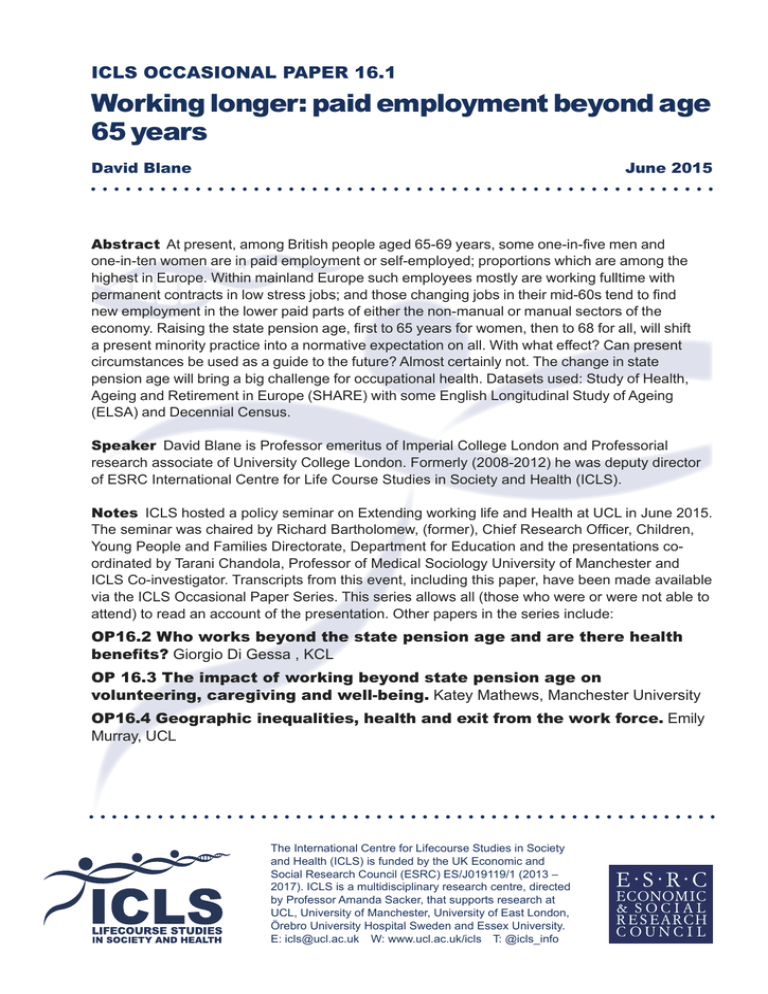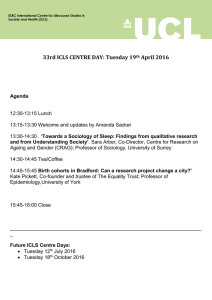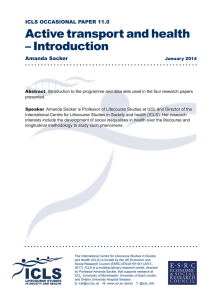
ICLS OCCASIONAL PAPER 16.1
Working longer: paid employment beyond age
65 years
David Blane
June 2015
Abstract At present, among British people aged 65-69 years, some one-in-five men and
one-in-ten women are in paid employment or self-employed; proportions which are among the
highest in Europe. Within mainland Europe such employees mostly are working fulltime with
permanent contracts in low stress jobs; and those changing jobs in their mid-60s tend to find
new employment in the lower paid parts of either the non-manual or manual sectors of the
economy. Raising the state pension age, first to 65 years for women, then to 68 for all, will shift
a present minority practice into a normative expectation on all. With what effect? Can present
circumstances be used as a guide to the future? Almost certainly not. The change in state
pension age will bring a big challenge for occupational health. Datasets used: Study of Health,
Ageing and Retirement in Europe (SHARE) with some English Longitudinal Study of Ageing
(ELSA) and Decennial Census.
Speaker David Blane is Professor emeritus of Imperial College London and Professorial
research associate of University College London. Formerly (2008-2012) he was deputy director
of ESRC International Centre for Life Course Studies in Society and Health (ICLS).
Notes ICLS hosted a policy seminar on Extending working life and Health at UCL in June 2015.
The seminar was chaired by Richard Bartholomew, (former), Chief Research Officer, Children,
Young People and Families Directorate, Department for Education and the presentations coordinated by Tarani Chandola, Professor of Medical Sociology University of Manchester and
ICLS Co-investigator. Transcripts from this event, including this paper, have been made available
via the ICLS Occasional Paper Series. This series allows all (those who were or were not able to
attend) to read an account of the presentation. Other papers in the series include:
OP16.2 Who works beyond the state pension age and are there health
benefits? Giorgio Di Gessa , KCL
OP 16.3 The impact of working beyond state pension age on
volunteering, caregiving and well-being. Katey Mathews, Manchester University
OP16.4 Geographic inequalities, health and exit from the work force. Emily
Murray, UCL
The International Centre for Lifecourse Studies in Society
and Health (ICLS) is funded by the UK Economic and
Social Research Council (ESRC) ES/J019119/1 (2013 –
2017). ICLS is a multidisciplinary research centre, directed
by Professor Amanda Sacker, that supports research at
UCL, University of Manchester, University of East London,
Örebro University Hospital Sweden and Essex University.
E: icls@ucl.ac.uk W: www.ucl.ac.uk/icls T: @icls_info
ICLS Occasional Paper 16.1
Working longer: paid employment beyond age 65
years
David Blane, June 2015
SLIDE 1
Good afternoon. My name is David Blane.
I am a professorial research associate of
University College London and a member of ESRC
International Centre for Life Course Studies in
Society and Health (ICLS).
The people listed on the slide are co-authors
of what I’m going to say. Morten Wahrendorf is
emphasised because most of the results come
from his work. Collectively we are a strange
thing in the academic world because, apart from
me, we are a volunteer project working group,
including Katey Matthews who is making a
separate presentation.
Working longer: paid employment beyond
age 65 years.
Bola Akinwale, David Blane (PI), Rebecca Landy,
Katey Matthews, Morten Wahrendorf.
www.ucl.ac.uk/icls
SLIDE 2
Two big things have happened recently . One is
that now, for the first time in human history,
most people live in cities; the other is that in
countries like UK human beings mostly don’t
die in middle age anymore. The increase in life
expectancy at middle age is extraordinary.
The policy implications of people living longer
is being addressed not only in the UK in terms
of research programmes but also in most other
European countries which have similar research
programmes.
One, ‘Pension system reform and inequality
among older workers’ is a German programme
example, with similar ones elsewhere. In
Germany there’s a much clearer recognition
than in the UK about the policy context of
this change: they relate the old policy of early
retirement to the de-industrialisation which
affected Europe in the 1980s and 1990s; and
they see the change in policy to one of active
www.ucl.ac.uk/icls @icls_info
© 2015 Blane D. All rights reserved
Background
• Policy switch in many countries of Europe from
early retirement to active ageing (move from deindustrialisation to globalisation ?).
• Accompanied by funder-led research initiatives
eg. New Dynamics of Ageing and Extending
working lives (UK) and Pensions, system reforms
& inequality among older workers (Germany).
ageing as part of globalisation. In the UK
there’s much less discussion about that.
Page 1 of 6
.
SLIDE 3
This slide shows the people who are working in
paid employment beyond the present state
pension age at ages 65 to 69 years. As you can
see, it’s very much a minority practice in England
at the moment. Although England has one of the
highest rates in Europe, it’s still only 20% of
men and 10% of women working in paid
employment at ages 65-69 years.
Raising the State Pension Age will turn a
minority practice into a normative expectation
on all. We are moving into interesting territory.
Footnote: ELSA = English Longitudinal Study of
Ageing. SHARE = Study of Health, Ageing and
Retirement in Europe.
Present proportion of 65-69 year-olds in
England employed or self-employed
(ELSA/SHARE).
England
Europe (range x country)
Men
18.2% (4 highest in Europe)
26.1-0.0%
Women
9.9%
21.7-0.0%
th
(3rd highest in Europe)
Working 65-69 in Britain: 1/5 men; 1/10
women
www.ucl.ac.uk/icls
SLIDE 4
When you look at the workers who work beyond
the state pension age, beyond 65 years in Europe
they’re nearly all employees (in the following
tables I put first the 65-70 year olds followed by
55-60 years olds, to emphasise change from the
years of working life).
As you can see, among women the proportion
of who are working at older ages as employees is
a little higher than during the years of working
life, whereas among men the proportionate
change is greatest among the self-employed.
So most older workers are employees or selfemployed men.
Employment status of European workers
aged 65-70 years and 55-60 years;
proportions (SHARE).
65-70 year-olds
55-60 year-olds
Women
Men
Women
Men
Employees
75%
55
70
70
Civil servants
5%
5
20
10
40
10
20
Self-employed 20%
Most 65-70 workers in Europe are employees or self-employed
men.
SLIDE 5
If you look at the hours and job security of those
working beyond 65, most are working fulltime and have permanent contracts. Part-time
workers are only about one-third of the total and
less than one-fifth have short-term contracts.
Hours & conditions of those presently
employed at ages 65-70 years and 55-60 years;
women & men combined (SHARE).
65-70 years
55-60 years
Fulltime
65%
70
Part-time
35%
30
Permanent
86%
92
Short-term
14%
8
Hours
Type of contract
Most 65-70 workers in Europe are fulltime & permanent.
www.ucl.ac.uk/icls
ICLS Occasional Paper 16.1, June 2015
Working longer: paid employment beyond age 65 years.
www.ucl.ac.uk/icls @icls_info © 2015 Blane D. All rights reserved.
Page 2 of 6
David Blane
SLIDE 6
This slide reports two measures of work stress:
Siegrist’s effort-reward imbalance; and
Karasek’s job control (where the slide says
high effort- reward imbalance, it means high
imbalance & high stress; similarly, where it says
that low job control is high, it means high job
stress).
As you can see, when you compare the people
who continue working after age 65 years with
those at a younger ages, people shun the jobs
with high effort-reward imbalance and those
that have low autonomy & job control. And the
jobs which are popular after age 65 years are
those with low effort- reward imbalance and
Level of occupational stress experienced by
employed 65-70 & 55-60 year-olds (SHARE).
65-70 years
EffortReward
Imbalance
Low
Control
55-60 years
Women
Men
Women
Men
High
20%
20
30%
33
Medium
30%
35
35%
34
Low
50%
45
35%
33
High
18%
18
25%
21
Medium
32%
24
29%
30
Low
50%
58
46%
49
65-70 workers in Europe shun high occupational stress jobs.
www.ucl.ac.uk/icls
high autonomy & job control.
People working over 65 in Europe shun high
occupational stress jobs.
SLIDE 7
In terms of social class, you can see that older
workers in Europe are attracted to jobs in the
advantaged social classes, with the proportion
of professional and managerial employees of
social classes I & II increasing somewhat at
older ages. Among manual workers in contrast
(social class IIIM skilled manual; social class
IV semi-skilled manual; social class V unskilled
manual), the proportions change little. The big
change is that those who work beyond age 65
years shun skilled non-manual jobs of social
class IIIN.
Social class (Registrar General) distribution of
those employed at ages 65-70 years and 55-60
years (SHARE)
Social class
65-70 years
55-60 years
I
27%
21
II
15%
13
IIIN
26%
36
IIIM
16%
15
IV
4%
5
V
12%
10
65-70 workers in Europe attracted to social class I & II jobs.
www.ucl.ac.uk/icls
SLIDE 8
This slide compares all those who work beyond
age 65 years with those who changed jobs
around the state pension age (older workers who
had been in their present job for less than six
years).
If you draw an imaginary line between social
class IIIN and social class IIIM, you have white
collar workers above the lie and blue collar
workers below. As you can see, within each of
the blue and white collar groups, older workers
who changed jobs recently are more likely to be
employed in the low paid, most disadvantaged
Social class (Registrar General) distribution of
those employed at ages 65-70 years x length of
time in job (SHARE).
Social Class
All 65-70 years
Less than 6 years
I
27%
24
II
15%
11
IIIN
26%
28
IIIM
15%
11
IV
4%
6
V
12%
20
Late job change associated with social class disadvantage within both
non-manual and manual sectors.
ICLS Occasional Paper 16.1, June 2015
Working longer: paid employment beyond age 65 years.
www.ucl.ac.uk/icls @icls_info © 2015 Blane D. All rights reserved.
www.ucl.ac.uk/icls
Page 3 of 6
David Blane
SLIDE 8 … CONTINUED
occupations.
So late job changes are associated with social
disadvantage within both non-manual and
manual sectors.
SLIDE 9
So to summarise: a minority of people in early
old age work beyond 65 years, about 10% of
women and 20% of men. This minority mostly
work as employees, full-time with permanent
contracts in low stress jobs. And that those who
change jobs around the state pension age are
more likely to work in the lower paid parts of
both the non-manual and manual sectors.
65-70 workers now: summary.
A minority of people in early old age work beyond 65
years (1/10 women, 1/5 men); of these:
•Mostly working as employees, fulltime with
permanent contracts in low stress jobs.
•Those changing jobs around state pension age are
more likely to find new work in the lower paid parts
of both the non-manual and manual sectors.
www.ucl.ac.uk/icls
SLIDE 10
This slide shows how Moritz Hess, of the German
project mentioned earlier, sees the situation:
the probability of working beyond 65 years has a
U-shaped social distribution, being lowest in the
middle and highest among the most advantaged
social class and, to a lesser extent, among the
most disadvantaged social class.
Importantly, the motivation of these two
groups differs: the most advantaged continue
working because they enjoy it - it’s a pleasure ;
the disadvantaged, in contrast, are more likely
to continue working for financial reasons – they
need the money.
When I started the project I assumed most
people who worked beyond age 65 years would
be in disadvantaged group, so was surprised to
find the high levels of working beyond 65 in the
most advantaged social class. Now I think of it
as catching up: the advantaged mostly went to
university, so didn’t start paid employment until
four, five, six, seven years after those who left
school at the minimum school leaving age, so
working longer makes up for starting later.
Social class and present prevalence of working
past age 65 years: motivations.
$
Working beyond age 65
years.
Most disadvantaged
Most advantaged
Social class.
Graph courtesy of Moritz Hess.
ICLS Occasional Paper 16.1, June 2015
Working longer: paid employment beyond age 65 years.
www.ucl.ac.uk/icls @icls_info © 2015 Blane D. All rights reserved.
Page 4 of 6
David Blane
SLIDE 11
Raising the state pension age first to age 65 for
women and then to 68 for all will shift a present
minority practice into a normative expectation
on all women and men
In terms of the likely effect of this change,
can present circumstances be used as a guide to
the future. Can we assume that when everybody
has to work until age 68 years that mostly they
will enjoying it? I suspect the answer is almost
certainly not. Many of the conscripts will be in
poor health. Many will find that the jobs they get
will have high effort-reward imbalance and low
job control, reducing their quality of life. Many
will be torn between volunteering, informal
caring and paid employment. And I think an
aspect which largely has gone unnoticed is the
challenge it will to pose for occupational health,
about which I’ll say a bit more soon.
The big question.
• Raising the state pension age, first to 65 years for women,
then to age 68 for all, will shift a present minority practice
into a normative expectation on all. With what effect ?
• Can present circumstances be used as a guide to the
future ? Almost certainly not.
• Many conscripts will be in poor health. Many will find that
high ERI-low control jobs reduce their quality of life. Many
will be torn between informal caring, volunteering and paid
employment.
• A big challenge for occupational health.
www.ucl.ac.uk/icls
SLIDE 12
This slide shows some information from the
Office for National Statistics. On the vertical
axis is disability-free life expectancy; on the
horizontal axis neighbourhood income or
deprivation.
For present purposes, ignore the top line
(life expectancy) and look at the lower one
(disability-free life expectancy). As you can see,
at the present retirement age of 65, something
like two-thirds of the areas have most people
with at least one limiting long-standing illness,
a figure that will increase to around 90% by the
time the state pension age reaches age 68 years,
unless levels of health improve before then.
Hence the challenge to occupational health.
Disability-free life expectancy at birth x deprivation of
area of residence at age 65 years
ICLS Occasional Paper 16.1, June 2015
Working longer: paid employment beyond age 65 years.
www.ucl.ac.uk/icls @icls_info © 2015 Blane D. All rights reserved.
Page 5 of 6
David Blane
SLIDE 13
How can we predict what’s going to happen?
One of the ways is to look at countries
where the state pension age has already been
increased beyond 65 years. Our project compares
England with Norway, Czech Republic and Italy
each of which were chosen to represent different
types of welfare state regimes. We have parallel
analyses under way in these countries so we’ll
see whether there’s much difference.
A second way is simulation modelling. Bola
Akinwale and Rebecca Landy will take baseline
frequencies from the Office of National Statistics
Longitudinal Study and transition probabilities
from the British Household Panel Survey and use
those to try and project what’s likely to happen.
We continue to be interested in other
possibilities.
How to predict what will happen ?
1. Look at countries where state pension age already
has been increased beyond age 65 years (project
will compare Norway, Czech Republic, Italy,
England).
2. Simulation modelling (project will take baseline
frequencies from ONS Longitudinal Study and
transition probabilities from British Household Panel
Survey).
3. Any other ideas ?
www.ucl.ac.uk/icls
SLIDE 14
Finally, what are the occupational health
implications raising the state pension age?
A large number of older workers will re-join or
stay in paid employment with many suffering
from at least one limiting long-standing
illness. Occupational health services at present
have quite modest resources and possibly
inappropriate training to meet this challenge.
How will those who work in occupational health
identify the older employees on whom they
should concentrate?
Occupational health.
• Raising the state pension age will mean that
several million older workers remain in paid
employment.
• Most will suffer from at least one limiting long-term
illness.
• How will occupational health services know on
which of these workers to concentrate their limited
resources ?
www.ucl.ac.uk/icls
SLIDE 15
ICLS
LIFECOURSE STUDIES IN
SOCIETY AND HEALTH
Bridging social and biological sciences
www.ucl.ac.uk/icls
@icls_info
ICLS Occasional Paper 16.1, June 2015
Working longer: paid employment beyond age 65 years.
www.ucl.ac.uk/icls @icls_info © 2015 Blane D. All rights reserved.
Page 6 of 6
David Blane




